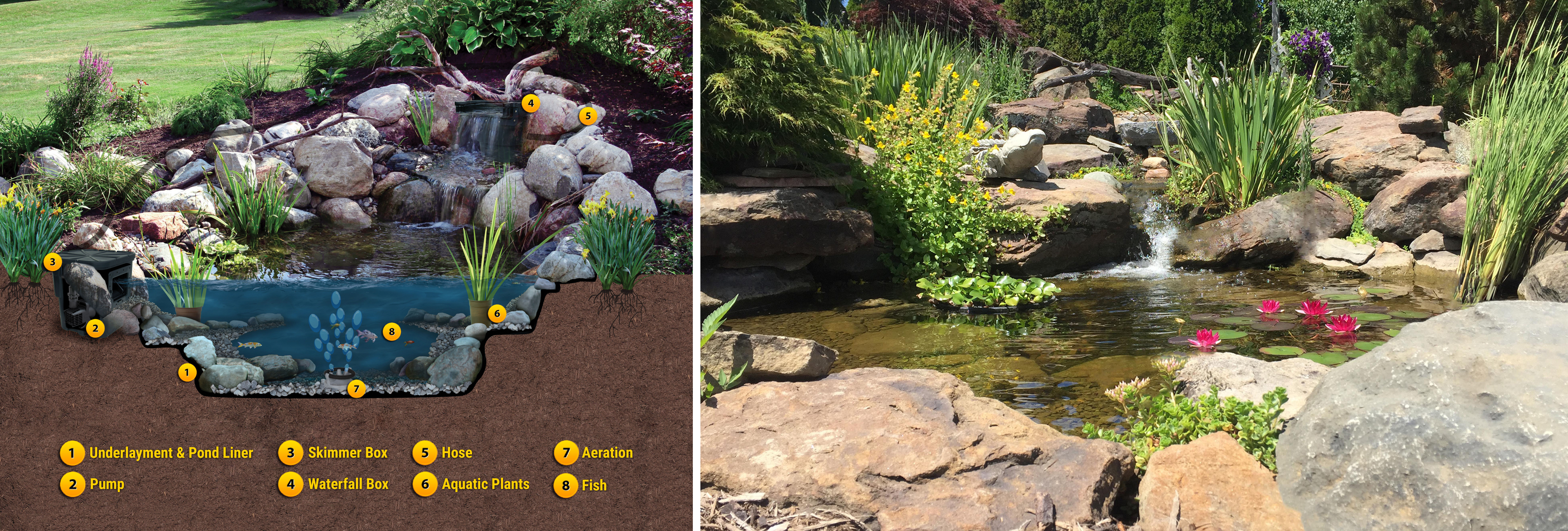What's the difference between a lake and a pond?
What's the difference between a lake and a pond? If we're comparing two naturally occurring bodies of water, then size is what matters. If we are speaking in terms of the treatments for a lake versus the treatments for a koi pond (or backyard water garden), then there is much more to discuss.
Is it a Lake, a Pond, or a Water Garden?
A body of water created for retention, fed by a natural spring or sustained by high water tables typically have what we call an “earthen bottom”. This means that there is no rubber liner containing the water within. Most likely it holds the water with a heavy clay base - either pre-existing or added as bentonite clay.
Unofficially, the main difference between a lake and a pond, as they exist in nature, is the surface area and depth…but mostly the depth.
A lake is typically 5 surface acres or more with depths beyond 10 or 12 feet. A pond, simply put, is smaller and shallower.
Another characteristic could include the idea of aquatic plants growing in the water. A lake would be too deep and too wide for sunlight to reach the bottom, leaving the shore line as the only place for plants to grow; while a pond would be shallow enough to allow sunlight to penetrate and permit photosynthesis below the surface.
Earthen bottom bodies of water are mainly self-sustaining with little need for maintenance (mind you, I did not say no maintenance). But a self-contained water garden, built in a back yard with a rubber liner, filtration system and well stocked with colorful fish…well, you can see the difference.

How to Maintain an Earthen Bottom Pond:
Left to its own defenses, a pond of this nature (one without a rubber liner) can become overwhelmed with a buildup of debris. This can cause it to become shallower over time and over-come with algae blooms thus an imminent threat of fish kill. Prevention is best with simple maintenance.
- Aeration is crucial.
Decomposing material such as leaves, sticks and dead vegetation use dissolved oxygen out of the water as they break down. The warmer the water, the less dissolved oxygen there is, and the pond will hold all of its oxygen at the surface. Once oxygen levels are used up in the lower levels, debris sits on the bottom and waits. Anaerobic bacteria (needing no oxygen) begin to take over and cause toxic gases to build up in the bottom of the pond.
*A good indication of lack of oxygen is what looks like an oil spill on the water. Areas of the surface that seem to have a rainbow appearance.
A pond aeration system increases circulation which lowers water temperatures and improves the capability of retaining dissolved oxygen. Sustained oxygen levels will help debris decompose at a faster and healthier rate while promoting gas exchange at the surface. Good bacteria will naturally colonize in the substrate over time.

- Beneficial Bacteria and Enzymes can be added to boost the decomposition activity. This will help reduce muck build-up.
Algae and other aquatic plant life (like duck weed) feed on the muck build-up in a pond. With the combination of having proper aeration in place and adding bacteria and enzymes (like Pond Basics Lake Balance Bacteria or Care Free Enzymes Lake Protector) to your earthen bottom pond will accelerate the aerobic decomposition of muck and debris. This will leave little nutrients in the water for algae blooms.
*For a more in-depth explanation, read our blog on “Pond and Lake Management” or click HERE for a guide from Atlantic Water Gardens. It talks about aeration, bacteria and treatments that help clean, clear and balance larger ponds and lakes.

How to Maintain a Garden Pond:
OR Water Garden, Backyard Pond, Koi Pond – whatever you prefer to call it..
Keep in mind that a backyard koi pond can be much smaller in size and depth, it is lined with a rubber pond liner [1] (that does not provide natural bacteria from the ground underneath) and is stocked with fish at a much higher percentage compared to a farm pond with an earthen bottom. Not to mention, we expect them to stay crystal clear so that we can see every pebble on the bottom. All of this is achievable, but with more effort:
- Filtration is key. There are 3 main types of pond filtration and each has its own job to perform. We have found that having a combination of a biological filter [4], mechanical filter [3] and aquatic plants [6] working together is the best solution for keeping your pond water clean, clear and healthy.
- Circulation is what makes the pond’s filtration system work. Properly fitted hose [5] leading from the pump [2] to the waterfall will allow adequate amounts of water to flow through the skimmer (mechanical filter) and the waterfall box (biological filter) and then back to the pond where the plants are living.
- Water Treatments of beneficial bacteria, like Pond Basics Pond Starter Dry Bacteria, added on a regular basis will colonize in the biological filter to help break down fish waste (ammonia) and decomposing matter turning them into useful plant nutrients (nitrates) which help filter the water leaving it crystal clear.
- Aerator Stones [7] in your pond will increase circulation of settling debris. This helps the debris to be filtered out through the skimmer or allows for it to be broken down faster by the good bacteria due to the higher amounts of dissolved oxygen in the water.
The end result is a beautifully clear water garden with a balanced eco-system, happy healthy fish and envious friends and neighbors.
What is a Lake | What is a Water Garden | What is a Pondless Water Feature
